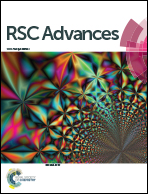Effects of Li2MnO3 coating on the high-voltage electrochemical performance and stability of Ni-rich layer cathode materials for lithium-ion batteries†
Abstract
Both the high-voltage electrochemical performance improvement and the storage improvement of Ni-rich layer cathode materials have been investigated. The performance improvement is achieved by a surface modification, involving Li2MnO3 as the coating layer. Owing to the composite structure, the Ni-rich layer cathode material has a stable interface, resulting in the improvement of the high-voltage cycling performance (the initial discharge capacities of 202.5 mA h g−1 and the capacity retention of 86.4% over 50 cycles at 3.0–4.5 V vs. Li/Li+). The differential scanning calorimetry (DSC) measurements show that the improved material presents a much lower calorific value than the pristine material. The perfect electrochemical properties of the improved composite material are still maintained after the material has been exposed to air for 2 months. The Fourier-transform infrared (FT-IR) spectroscopic analysis indicates that the formation of Li2CO3 on the material surface is suppressed. Obviously, the as-improved composite material maintains stable features after high-voltage cycling and is much easier to be stored.


 Please wait while we load your content...
Please wait while we load your content...